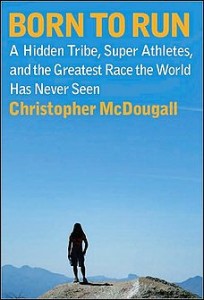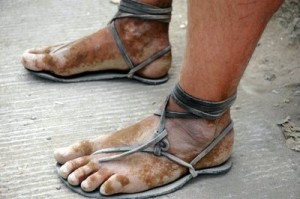A book review from an optimist’s and a pessimist’s point of view
by Rhielle Widders – SLRC Employee
Early in 2009, customers started filing into our store asking if we carried the book, Born to Run. After repeated requests, I decided to look into this book; I am passionate about running, after all.

The Good
Born to Run re-introduces a running people, the Tarahumara Indians, who live deep in the heart of Mexico. These people have long been known as some of the best runners in the world, but this account delved deeper into the culture and their history as runners. The Tarahumara are not only known for running well, they are known for doing it without wearing running shoes. Instead, they wear a leather thong held on with straps that wrap around their ankle- a Greek sandal of sorts. With that, the book also re-introduces the art of barefoot running.
I am a huge advocate of barefoot running. As an athlete in high school and junior college, we would finish cross-country and track practice by taking our shoes off and running on the grass inside the track. Later, as a coach and running instructor, I instructed my students to do the same.
- The benefits of running sans shoes are three fold. The joints of the foot are allowed to flex and move in the way they were designed to.
- It forces the body to land on the forefoot or mid-foot, improving biomechanical efficiency and increasing speed.
- Running without shoes forces the foot and lower limbs to become strong enough to absorb the impact of running reducing the chance of overuse injury.
In other words, running barefoot could be considered the magic potion needed to make you fast and efficient. So, one must ask him/herself the question, “If running barefoot is so beneficial, why do we wear shoes?”
The Bad
According to Mr. McDougall, shoes were invented by Nike as a commercial expedition; “Nike created these pieces of shock absorbing foam and then told everyone who ran that they couldn’t do so without purchasing a pair.” As a person with extreme interest in biomechanics, I must tell you that it was sidewalks and asphalt, not Nike, that forced us to slip our feet into the pillows that we call running shoes.
As indigenous people, we ran on uneven, soft surfaces. As a result, our feet have evolved to be flexible enough to wrap themselves around the surface underneath our feet. Because we now live in a world that is flat and hard, our foot no longer has the ability or need to adapt to the surface it lands on. Enter running shoes and arch supports. These things were designed to absorb the extra impact that comes from running on a surface that doesn’t give back. Additionally, without the natural, uneven surface underneath our feet, we are forced to put one in there. Just consider a firm arch support your way of putting rocks, dirt mounds, and vegetation under your foot.

The Ugly
Because this book talks so much about the Tarahumara, running, and going barefoot, the book also reintroduces a previously unknown shoe called the Vibram 5-finger. This ‘shoe,’ made of a vibram rubber bottom and a cloth upper, looks like those toe socks from the fifth-grade with an individual spot for each toe. They do not have any cushion, shock-absorbents, or EVA built into them. They are designed to allow the body to run barefoot without the risks of hypodermic needle pricks or broken glass.
“Those 5-toe shoes,” as people like to call them, have essentially given barefoot running a rebirth. So, can you actually wear them around as every-day footwear or running shoes? The answer is yes, you absolutely can. Are they guaranteed to fix your shin splints, planar faciitis, or achilles heel? Probably not. Although many runners have discovered the magic of running barefoot, those same runners have also learned that it must be done carefully and in moderation. These shoes are perfect for running in parks or even trails, soft-uneven surfaces just like our ancestors did. However, because most of us don’t live in the wilderness but function as a part of our concrete society, I don’t recommend them for more than just a strengthening tool. You wouldn’t go into a gym and start bench pressing 100 lbs, so you shouldn’t try giving your body the full force of running without training.
Rather than going out the day after buying these and running a marathon, I would recommend a six-week, body-break-in in process.
- Start by incorporating every-day walking while wearing these shoes.
- Then, add a few minutes of running (about 10% of the total run time) into your workouts.
- Finally, gradually increase the time you are running in shoe over the course of the six-weeks while remembering that you should never increase your mileage by more than 10%/week.
The Rest
Born to Run has a way of speaking so greatly of the sport we love so much. For those of you ready to take the next step in your running career, it makes some great suggestions for taking things to the next level or to keep the pounding from becoming monotonous. Trail running, ultra-endurance races, and barefoot running are all ways of doing just that. Above all, Born to run is a great read about the lore of running and shouldn’t be passed up by any runner- young, old, novice, expert, or pro.
